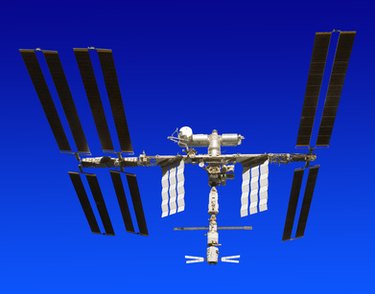
Since 1972, the world has employed communication satellites to revolutionize the way humans connect with each other. The uses of these satellites have evolved over time, but they still serve essential functions, primarily for business and entertainment purposes. Communication satellites facilitate many everyday interactions that we take for granted.
Television
Video of the Day
The most popular function of communication satellites is television service. No matter how you receive television in your home, a satellite is part of the process. TV networks and cable channels beam their signals to satellites, which are received by local stations and distributors such as cable companies. From there, the signal is broadcast to viewers. Those who subscribe to satellite television at home see the benefits of the technology directly, receiving television programming through a small residential dish. Television news operations also use the technology for live news reporting from the field, for beaming video and for reporting using specially equipped vehicles.
Video of the Day
Radio
Satellite radio is another popular consumer use of communication satellites in the United States. For a monthly fee, subscribers receive access to a variety of audio programs transmitted by satellite, making it possible for someone to hear the same signal anywhere in the country. The two most popular providers of this service in the U.S., XM and Sirius, combined operations in 2008. The company is now called Sirius XM. Satellite broadcasting also enables the service to be offered to subscribers through the Internet and on mobile devices such as smart phones.
Weather
Communication satellites are essential to meteorology, because they allow scientists to observe weather patterns around the world. Meteorologists use this information to collect data and predict future weather events. These forecasts are distributed to the public on the Internet, on television, and in newspapers. Anyone can access satellite images of the earth's weather patterns as part of forecasting data available through many weather-oriented websites. The images and information are updated by the satellites at regular intervals, which provides not only a snapshot of current conditions, but the opportunity to observe the formation of various weather patterns.
Global Positioning System (GPS)
An increasingly popular consumer use of satellites is GPS technology. Developed by the United States Department of Defense, the Global Positioning System provides free time and location information to anyone with a GPS receiver. Its navigational capabilities are popular for their ability to provide directions in automobiles.
Other Uses
In remote areas, satellites provide access to phone and Internet services. This capability has become obsolete in population-dense areas where broadband and cell towers are more cost-effective means of delivering these services. The military also makes use of satellite technology to coordinate communications. The broad picture satellites provide are also an aid to the accuracy of mapping.